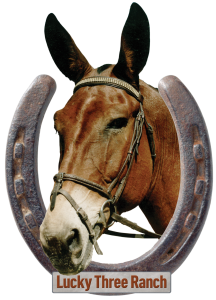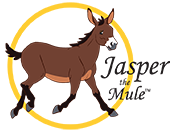 When buying an equine, ask for a soundness check from a reputable veterinarian. Check the health records and registration papers on the equine you are buying, and try him out a couple of times and visit him more than just once before taking him home. Buying at an auction is risky, so bring a knowledgeable person with you if you plan to bid at an auction, and make sure all paperwork is in order. The best place to buy is from a reputable breeder. Often, you can see both parents, the facility where they live, and the way they train. This can give you a clearer picture of the kind of equine you are buying. Ask for and check references.
When buying an equine, ask for a soundness check from a reputable veterinarian. Check the health records and registration papers on the equine you are buying, and try him out a couple of times and visit him more than just once before taking him home. Buying at an auction is risky, so bring a knowledgeable person with you if you plan to bid at an auction, and make sure all paperwork is in order. The best place to buy is from a reputable breeder. Often, you can see both parents, the facility where they live, and the way they train. This can give you a clearer picture of the kind of equine you are buying. Ask for and check references.
Click on the title below to see the complete question and answer.
Buying
Buying
Buying a Mule
Question: I’m looking to buy a young molly. She is not quite 1 year old. When I go to look at her, can you give me 1/2 dozen things to look for in confirmation and behavior?
Answer: Here are some things to look at:
1. While someone holds her lead, stand in front of her and just far enough away that she must stretch her neck to touch you. Take some dirt in your hand and let it trickle out of your hand and fall to the ground. What does the mule do? Is she curious? Does she ignore you or try to leave? This is a way to test the trainability of the animal and to test for a negative disposition. The animal with a trainable and amicable disposition is the one who is curious about what you are doing and does not get frightened and leave or ignore you. Her eyes should be soft and not fixed. Ears should be expressive and attentive. The mule should want to come to you.
2. Check the body for any scarring or signs of severe trauma, hernias, and irregularities.
3. Stand back and look at the animal’s overall structure. It should appear to be balanced and smooth. There should be a good and equal angle at the hip and shoulder and neither a back that’s too long nor too short. Legs should be set in square to the animal’s torso and be straight with clean bone. The animal should look as one animal, not one animal made from a lot of different parts.
4. Check the feet carefully for any flaws or inconsistencies, cracks, rotting, etc.
5. Check the teeth and compare to chart for accuracy of age and health.
6. Watch the animal while someone walks and trots him on the lead line. The gaits should be rhythmic and regular.
7. Get a vet check!
How much weight can my mule or donkey carry?
Question: How much weight can my mule or donkey carry?
Answer: Mules can carry proportionately more weight than a horse of the same size. However, there have never been any in-depth studies on this issue, so it’s best to be skeptical of statistics and avoid making broad generalizations. Obviously, an equine that is not conditioned properly will not be able to efficiently carry as much weight as one that is. Also, a rider with better balance and riding ability is going to be easier for the equine to carry than one who is not balanced, regardless of their actual weight. The equine’s size and his proportion to the rider will also affect balance and carrying ability.
If an equine is fit, he will be able to carry more weight than one that isn’t, but conformational abnormalities also play a role. Deviations in bone structure (i.e., crooked legs) can compromise movement and put undo stress on certain areas depending on the defect.
The easiest way to test for weight tolerance is to watch the way the animal moves. If he is halted and seems to be have difficulty moving, the weight is obviously too heavy. If he is unable to trot, or is resistant to trotting, the weight is too heavy. The same is true in harness. If he cannot move freely, the load is too heavy.
So it’s not just a matter of age. Conformation and fitness at any given stage of training, as well as the weight and ability of the rider, dictate how much an equine can comfortably carry or pull.
Mule-Donkey Location Help
Question: I would like to know if you can be of assistance to me in my search. My father would like to have a mule or a donkey. Since I am very supportive of the Human Society I thought that it might be a good idea for my father to search for a young mule/donkey that is not of show quality. I can assure you that this animal would end up being a pet.
My father has a piece of property that is fenced and plenty of water and food should be of no concern to the present owner, along with getting the animal current of shots. My father (many years ago) farmed with mules and donkeys. So now that he is retired he spends all of his him out on his acreage that he has.
My dad took care of “Buddy” for 3 months. He became so attached to this little guy that it was hard to see him go. Anyway, if you know of anyone in the CO, NE, MT area that may have a young one that needs a good home, thanks!
Answer: You are so very kind to be thinking of your father this way and I hope we can help you to find an animal that would do. Is he set on having a mule, or would a donkey do? If so, you might want to contact the Bureau of Land Management and see about adopting a young burro. If they are young enough, they need good homes and make excellent pets.
I no longer breed and sell mules to the public but you can check in the Classified Ads section at www.luckythreeranch.com and see if there are any offered, or you can put up your own ad asking for one. The service is free.
Registering Donkey with Unknown Parentage
Question: Can I register my donkey even if I don’t know who the parents are? She is such a lovely donkey and pretty, too.
Answer: Yes you can. Below are guidelines for donkey registry with the American Donkey and Mule Society.
The ADMS Registry Books
MDR – the Miniature Donkey Registry. Founded in 1958 by Bea Langfeld and now run by ADMS, this registry is exclusively for Miniature Mediterranean Donkeys. Up until 2009, any donkey under the height of 36” at the withers could be registered as long as it met basic type and conformation.
Since the numbers are now over 54,500, the book was closed to “untraced” donkeys in Jan 2009. This means that ONLY donkeys who have both parents already registered as Miniature Mediterranean donkeys will be placed in MDR.
If one or both parents are not registered as Miniature Mediterranean Donkeys, the donkey will be placed in the American Donkey/Jackstock Registry book.
ADR/ADJR The American Donkey/Jackstock Registry. Founded in 1967 by Paul & Betsy Hutchins, this book was open to donkeys of all sizes for many years. In the 1990s, Miniatures were put exclusively in the MDR book. However, a good number are still registered in ADR as “Miniature Mediterranean Donkeys.” Their offspring (providing both parents are MMDs) are eligible for inclusion in the MDR book.
Have a donkey of any size with no pedigree, but still want to register it? This is where they go! Unsure? Don’t worry, we’ll place them in the appropriate book.
(Remember, the key is BOTH PARENTS registered as Miniature Mediterranean Donkeys to go in MDR. Anything else goes in the ADR book.)
AMR – The American Mule Registry. Mules, hinnies, all sizes, all types. No pedigree? NO PROBLEM. However, any known pedigree or parent info is appreciated and will appear on the mule’s papers. Send a photocopy of the dam’s papers if you have them!
AMRR – for Racing mules. The American Mule Racing Registry covers anything (mule or hinny) that’s on the track. Slightly different registration form and rules apply. Ask for applications if you have a mule colt that’s destined to go into training for the track.
ZEHBRA – Zebras, Exotic Hybrids/Bloodstock Registry. For pure-bred zebras and their offspring, whether it is zebra x horse, pony or donkey.
Donkey Under 36” (or expected to mature so) – SIRE is registered Miniature Mediterranean Donkey, DAM is registered Miniature Mediterranean Donkey (MDR). Donkeys up to 38” at maturity will still be allowed with the Oversize rule.
Donkey Under 36” (or expected to mature so) – One Parent is registered Miniature Mediterranean Donkey, the other is registered American Miniature, European Miniature, British/English/Irish Miniature, or is unregistered. Donkey with untraced parents, or unregistered parents, under the height of 36″ at maturity (ADR). Larger Donkeys still go in ADR as well.
For more information about the ADMS, mail to P.O. Box 1210 Lewisville, Texas 75067, call (972) 219-0781, or visit www.lovelongears.com Join the American Donkey & Mule Society to receive their bimonthly magazine with even more valuable information for a mere $23/yr.
Should I Get a Mule?
Question: I live on a 30-acre farm in middle Ga. I have always been interested in Mules. I am a beginning rider. Should I get a mule? If so what kind, how old, how big etc.
Answer: I think you should do a little research before you make up your mind. If you are a beginning rider, then you should do this anyway. If you already have an interest in mules, then you should find out as much as you can about them, so you can decide just what type you would want.
We have developed a series of books and videos that can help you do that and when you decide what you would like to have in a mule, I know where to get it. Most people who had horses and tried mules don’t like to ride horses that much anymore!
Socializing New Mules
Question: We have a new mule and would like to know how we should socialize him with the others that we have. What should we do?
Answer: Generally, the best thing to do with a new animal is to put him in a pen of his own adjacent to the pens with your other animals for about two weeks, just so they can be introduced “across the fence” before you turn them in together. Jacks and stallions should never be turned in with other animals. When you finally do put your mule in with the others, they will establish a new pecking order. As long as they do not get completely vicious with each other, you can be reasonably sure that they will work this out and things will calm down over another two-week period. Of course, there may be irreconcilable differences in personality or size that will affect your mule’s behavior. If he is incompatible with the other animals, he may need to be kept by himself, or with a partner that is more suitable for him.


